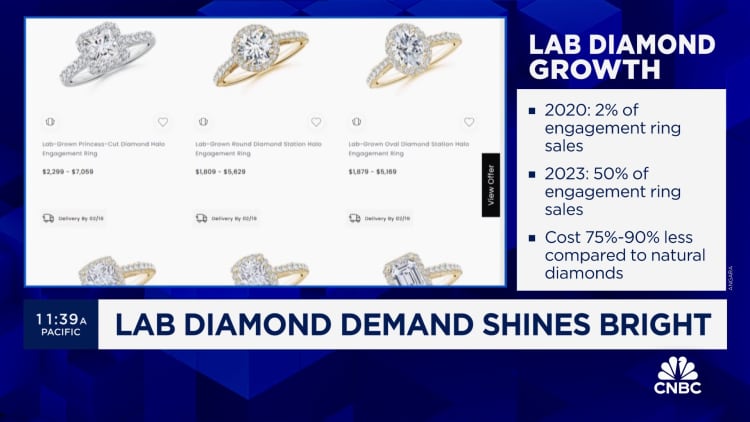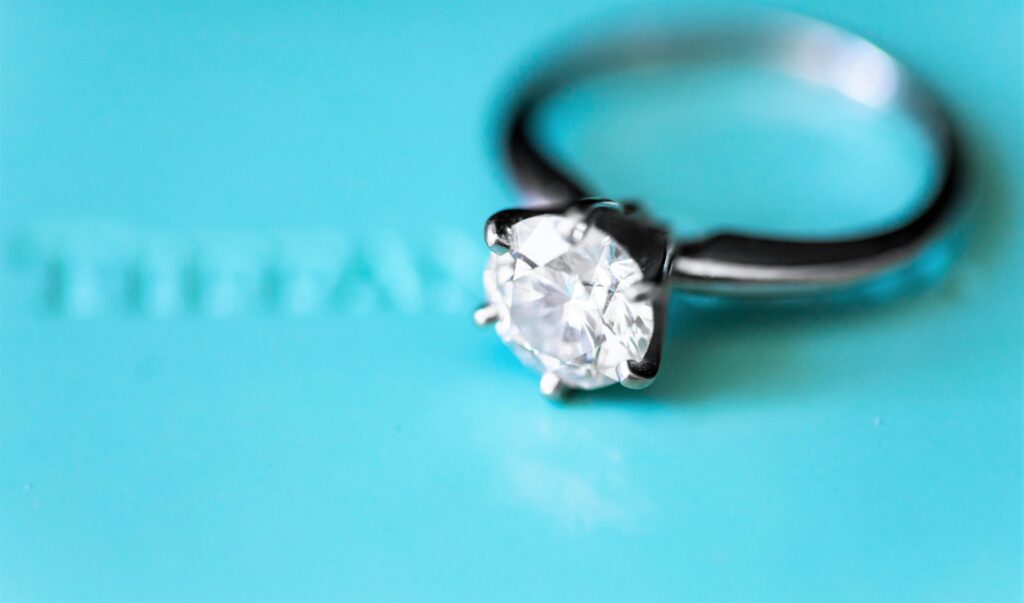If you’re over the traditional diamond engagement rings, you’re not alone! The world is beginning to embrace gemstone engagement rings, a trend swiftly capturing not only hearts but also a considerable share of the market. This changing trend is supported by numbers: a decade ago, colored gemstones made up just 5% of engagement rings, and now they account for more than 15%. The rise in lab-grown diamonds and the craving for uniqueness has fueled this shift. That dazzling sapphire, brilliant ruby, or even the serene aquamarine could be the next big thing in your hunt for the perfect engagement ring.
1. Popularity of Gemstone Engagement Rings
It’s fine to believe that diamonds are a girl’s best friend, but it seems like colored gemstones are stealing the scene lately. More and more couples are going beyond the traditional diamond solitaire engagement ring and embracing the enticing hues of gemstones.
A decade ago versus now: compare the percentage of engagement rings with colored gemstones
A decade ago, the percentage of engagement rings featuring colored gemstones was a mere 5%, according to Ankur Daga, founder and CEO of fine jewelry e-commerce company Angara. Fast forward to today, and you will see that number tripled, with more than 15% of engagement rings now boasting colored gemstones.
Survey Findings: Preference for Gemstone Engagement Rings
According to a survey commissioned by Angara, more than 20% of people would opt for an upgrade to a colored gemstone engagement ring if given the chance. This surge in interest shows the growing appeal of gems like emeralds, yellow diamonds, and pink sapphires among couples.
Factors influencing the shift towards colored gemstones
The rising popularity of lab-grown diamonds has been a game changer in the industry, possibly influencing the shift towards colored gemstones. Customer preference has also evolved, with many seeking a more unique and distinctive ring, hence the move away from traditional diamond sparklers.
2. Gemstone Trends in the Jewelry Industry
Several trends in the jewelry industry have also played a role in the rising popularity of gemstones.
Seller perspective: Insights from CEOs of jewelry companies
Insiders in the jewelry industry have noticed the shift towards gemstones. Sellers are seeing increased consumer demand for gemstones across a range of jewelry pieces, not just engagement rings.
Most popular gemstones in engagement rings
Among the frontrunners in the gemstone race are sapphires, rubies, and morganites, with others such as London Blue Topaz, aquamarine, and green quartz also seeing a surge in interest.
Emerging trend of personalized engagement rings
One key trend transforming the jewelry industry is the move towards personalized engagement rings. Gen Z, in particular, is driving this trend, with many individuals preferring pieces that reflect their personal style and unique personalities.
3. Rising Demand for Gemstones
As more people fall in love with the allure and charm of gemstones, demand for these colored stones is skyrocketing.
Increase in consumer interest in colored gemstones
Across the board, there has been a significant increase in consumer interest in colored gemstones. This interest extends beyond engagement rings to other jewelry items, driving overall demand.
Influence of Gen Z’s preferences on gemstone popularity
The preferences of Gen Z have a massive influence on the rising popularity of gemstones. Often regarded as the seekers of uniqueness, this generation prefers items that speak to their distinctiveness, hence, the appeal of multicolored gemstones that offer variety and personalization.
Challenges in sourcing gemstones due to growing demand
The ever-growing demand for gemstones, however, comes with challenges. Sourcing quality gemstones is becoming more difficult, especially for specific stones like rubies and exotic varieties, due to limited supply regions.
4. Supply Constraints Facing the Gemstone Market
As demand increases, the gemstone market has to grapple with various supply constraints.
Availability issues for certain types of gemstones
There are issues surrounding the availability of certain types of gemstones. Many natural gemstones are experiencing tighter supply, driving up their prices and making them even more sought after.
Hindrances in sourcing gemstones from specific regions
Due to constraints in extraction and geographical limitations, sourcing gemstones from specific regions has become a challenge. As an example, the closure of Burmese and Kashmir mines has left Madagascar and Sri Lanka as the primary suppliers for sapphires.
Implications of supply constraints on market prices
Supply constraints are inevitably pushing up gemstone prices. Sapphires, for instance, have seen wholesale prices increase by 12% annually over the past three years, with emeralds and rubies experiencing similar hikes.

5. Gemstone as a Luxury Good
With their vibrant colors and increasing scarcity, gemstones are well on their way to becoming luxury goods.
Role of color in luxury commodities
Colored luxury goods are in vogue, and this extends to the jewelry industry. People are drawn to colorful brands, and the unique colors found in gemstones make them even more attractive.
Implications of market trends on gemstone as an asset class
Given the shift in supply-demand dynamics and the growing appreciation for color in the luxury goods market, gemstones are increasingly becoming seen as attractive investment assets.
Insights from recent auctions
Recent auctions of gemstones at esteemed auction houses such as Bonhams, Sotheby’s, and Christie’s have revealed a significant uptick in prices, with over half of the gemstone lots selling above the high estimates.
6. Gemstone Price Trends
As demand continues to rise and supply remains constrained, there have been noticeable trends in gemstone prices.
Price increases across different gemstones over the past three years
The escalating prices are evident across a range of gemstones, with some like pearls and opals experiencing annual price increases of over 20% and tourmalines seeing prices climb up to 36% a year.
Comparison of gemstone prices with the S&P 500 stock index
To put these price trends in perspective, consider this: The compound annual growth rate of the S&P 500 stock index is 10.5% over the past three years. In contrast, the prices of many gemstones have grown at a much higher rate, making them potentially lucrative investments.
Future predictions for gemstone prices
Given the current market conditions and trends, it’s reasonable to predict that gemstone prices will continue rising. As these gemstones grow rarer and demand increases, they may become even more precious and valuable.

7. Lab-Grown vs. Natural Gemstones
When it comes to gemstone preference, consumers are quite discerning, with the majority still pine for naturally occurring gemstones over their lab-grown counterparts.
Preference ratio among consumers shopping for colored gemstones
About 75% of consumers shopping for colored gemstones still prefer the allure and unique properties of natural stones, despite the perfection and identical properties of lab-grown alternatives.
Attributes of lab-grown gemstones
While lab-grown gemstones are chemically, physically, and optically identical to natural gemstones, they often look too perfect to the discerning eye.
Implications of lab-grown gemstones on the jewelry market
As the technology for creating lab-grown gems improves, the implications for the jewelry market could be significant. While the market’s current preference is still tilted towards natural stones, changing trends may influence this in the future.
8. Appeal of Unique and Distinctive Gemstones
The charm of a gemstone lies not only in its hue but also in its unique characteristics.
Consumer love for inclusions and imperfections in gemstones
Consumers are increasingly appreciating gemstones for their inclusions, or what are commonly known as imperfections. These “flaws” add a certain charm and uniqueness to each stone, making it one of a kind.
Appreciation for the unique qualities of gemstones
No two gemstones are exactly alike, and this uniqueness is part of their appeal. From varying hues to individual inclusions, the distinct characteristics that each gemstone brings to the table are causing consumers to fall in love with them.
How uniqueness drives value and demand
This appreciation of uniqueness is driving the value of and demand for gemstones upward. The more distinctive a gemstone is, the more valuable and sought after it becomes.

9. Influence of Valentine’s Day on Gemstone Market
Valentine’s Day plays a significant role in the gemstone market. This date, synonymous with love and romance, sees a surge in jewelry purchases.
Surge in gemstone jewelry purchases during Valentine’s season
During Valentine’s season, couples express their love through jewelry, often featuring colorful gemstones. This demand significantly contributes to the total annual spend on jewelry.
Most popular stones for the Valentine’s season
Amethyst and ruby remain the top choices for Valentine’s season due to their vibrant hues and their association with love and passion.
Impact of Valentine’s Day sales on annual market trends
The sales during the Valentine’s season can influence market trends for the rest of the year. This holiday demand often sets the tone for what gemstones and jewelry styles stay popular throughout the year.
10. Comparative Assessment: Diamonds vs. Gemstones
Despite the increasing popularity of gemstones, diamonds still hold a significant place in the market, even though it has witnessed a sharp turn towards lab-grown alternatives in recent years.
Analysis of the growing trend towards lab-grown diamonds
Over the past three years, the market for diamonds has veered strongly towards lab-grown diamonds, accounting for 50% of diamond engagement ring purchases last year.
Comparison of demand for diamond and colored gemstone engagement rings
While lab-grown diamonds are gaining popularity, especially among environment-conscious buyers, gemstones continue to carve their niche as distinctive, personalized alternatives, providing a rich palette of colors and varieties to choose from.
Reflection on future market trends inspired by current shifts
The preference for colorful and unique gemstones is provoking a shift in market trends. As consumer preferences continue to evolve, it can be expected that gemstones will continue on their trajectory of popularity, serving as a key driver of future trends in the jewelry industry.

